Why Lead Capture Matters in Social Media ?
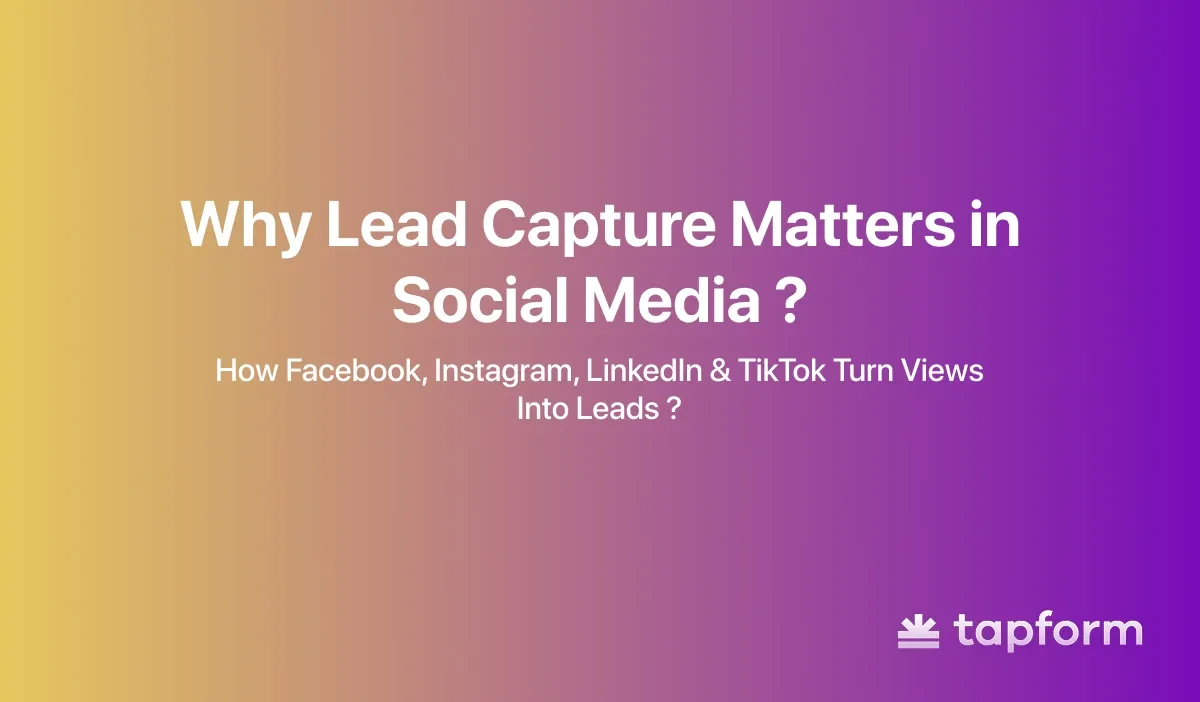
Social media platforms streamline lead capture. By offering value for contact details, brands turn scrollers into prospects. Each platform has its strengths, but results rely on concise, mobile-friendly, and trustworthy forms.
Lead capture forms on social media turn views into leads by offering value in exchange. They can appear directly in apps like Facebook, Instagram, LinkedIn, or TikTok.
Each platform serves a different audience:
- Facebook and Instagram are most effective for B2C marketing.
- LinkedIn excels at B2B.
- TikTok is great for reaching younger users fast.
Regardless of the platform, high-converting forms share certain characteristics. High-converting lead forms are concise, clear, mobile-friendly, and designed with trust and psychology in mind.
Understanding Social Media Lead Capture Forms
Lead capture forms are digital tools that make it easy to collect contact information from users who have already shown interest in your offer, for example, after they click an ad or visit your profile. Sometimes, they include a small incentive (like a free guide or discount) to encourage action, but their main goal is still to capture existing interest, not to generate it from scratch.
The HubSpot study shows that companies with lead capture forms generate 55% more leads than companies without one.
On-Platform vs Off-Platform Lead Forms:
There are two main ways to collect people's information on social media:
On-Platform Forms appear within apps like Facebook or Instagram, allowing users to complete them without leaving the app.
Off-Platform Forms require people to click a link and visit your website. While you gain more control over how the form looks, fewer people complete it because it requires extra work.
On-platform forms work about 3 times better because people don't want to leave their favorite social media app.
Key Form Fields and Their Impact
The questions you ask in your form are really important. Some of the most important data to capture are:
- Name - Makes messages feel personal ("Hi Sarah" vs "Hi there")
- Email Address - Essential for staying in touch
- Phone Number - Great for quick follow-up, but many people hesitate to share
- Company Name - Useful for business leads, but scares away regular consumers.
In short, the more questions you add, the fewer responses your form will get. For example, forms with only 1 to 3 questions achieve a 25% completion rate, while forms with 7 or more questions achieve only an 8% completion rate (Unbounce).
Platform-Specific Lead Capture Strategies
Each social platform assumes a slightly different role, depending on user intent and campaign objectives. Facebook and Instagram are the top platforms for generating B2C leads, where users browse for entertainment and respond highly to social proof, promotions, and visual content. They work with consumer brands, retail, and service companies that benefit from scale and a low cost per lead.
LinkedIn is best suited for B2B lead generation, allowing for precise targeting by job title, company, or industry. You get fewer, but higher-quality, leads. Use LinkedIn when professional intent outweighs volume for SaaS, consulting, or enterprise services.
| Platform | Best For | Benefits | Disadvantages |
|---|---|---|---|
| Facebook & Instagram | B2C leads, retail, consumer services | High reach and low cost per lead; strong visuals and social proof drive engagement | Lower lead quality; users often browse for entertainment, not intent |
| B2B leads, SaaS, consulting, enterprise | Precise targeting by job title, company, or industry; high-quality professional leads | Smaller lead volume; higher advertising costs | |
| TikTok | B2C, ecommerce, lifestyle, youth audience | Fast reach; creative content performs well; low-cost customer acquisition | Leads often need extra qualification; short attention span of users |
| X (Twitter) | Events, product launches, real-time marketing | Great for urgency-driven and time-sensitive campaigns | Lower-quality leads; limited long-term engagement |
| Travel, home design, shopping inspiration | Strong at idea-gathering stage; good for long-term conversions | Medium-quality leads; slower conversion cycle |
TikTok has become rapidly powerful for new customer acquisition among B2C and young demographics. The discovery-driven feed and content-first creative approach enables businesses to generate a high volume of leads, although these leads often require further verification. TikTok is a great fit for e-commerce, lifestyle products, and services that require broad awareness and fast conversions.
Others like X (Twitter) and Pinterest serve more niche purposes. X is fantastic around events, product launches, and real-time campaigns that demand urgency and timeliness; however, the quality of leads tends to be on the lower side. Pinterest excels in planning and aspirational verticals, such as travel, home design, and shopping, where it generates medium-quality leads from users who are in the idea-gathering stage but are likely to convert eventually.
Lead capture forms on Facebook examples
On Facebook, potential clients can fill out Lead Ads (or Instant Forms). This sharing of information is done without exiting the app, making it a fast and low-friction process for the user. The form is autofilled with profile data such as name, email, and phone, and as a result, the completion rates tend to be higher than landing-page conversions. Most companies restrict forms to between three and five fields to keep them user-friendly.
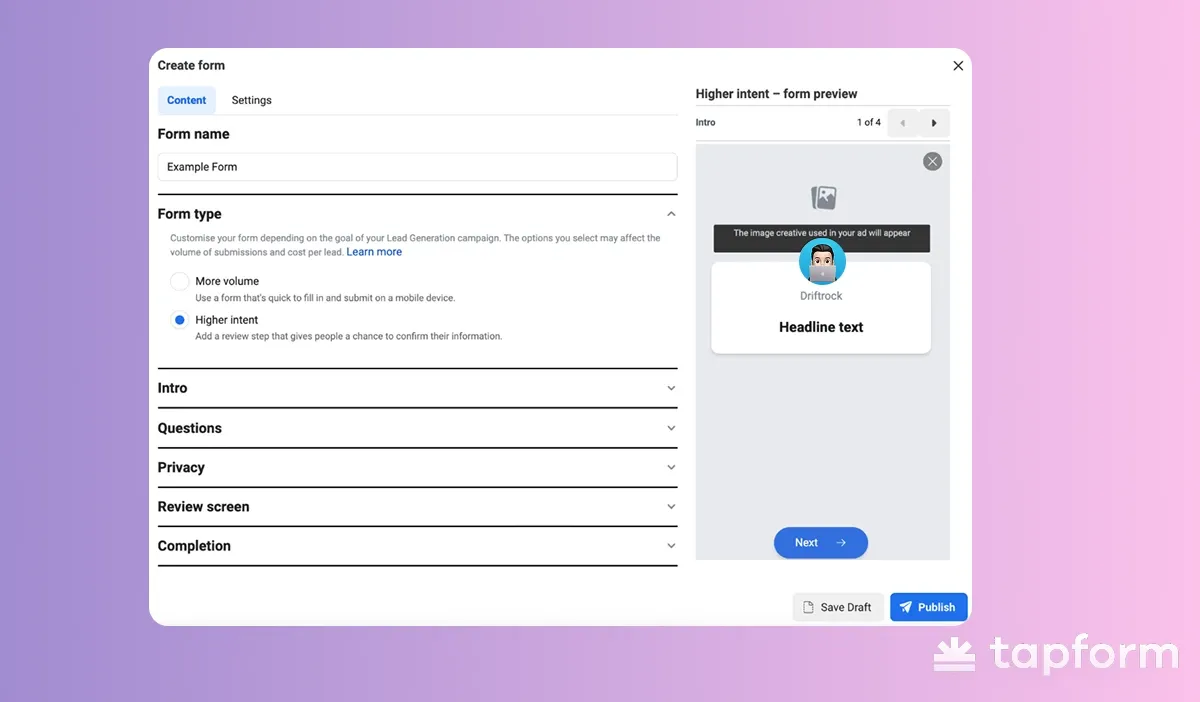
The settings within Facebook Ad Manager are pretty straightforward: first, you select "Leads" under campaign objective; go ahead and choose "Instant Forms"; then you build the form by providing a headline, a short description, and a handful of really basic fields. You can also select either a more volume-centric form or a high-intent form. The latter version features a brief review screen to filter out casual sign-ups.
Lead capture forms on Instagram examples
Instagram comes with a built-in lead capture form that can be added to the business profile, along with the button. Using these forms, followers can send their information without having to leave the app, making the process all the more efficient and fluid for capturing information. Custom forms enable you to add questions tailored to your specific service or product.
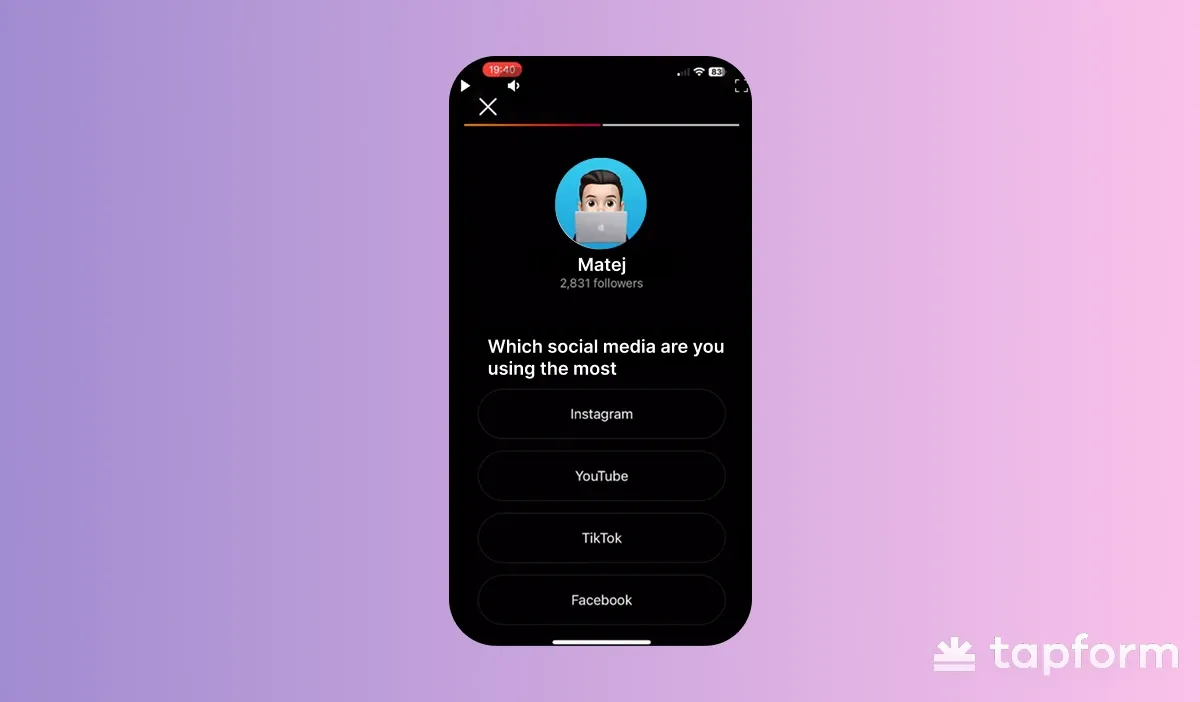
To do so, go to Edit Profile → Action Buttons → Add Lead Form, and from there, proceed to choose between the standard form or a custom one. The custom ones allow for multiple-choice or short-answer questions, giving you the opportunity to learn more about your audience, while also requiring a link to your privacy policy before publishing.
Lead capture forms on LinkedIn examples
LinkedIn Lead Gen Forms are built for B2B campaigns and appear directly within sponsored posts. Instead of sending users to another website, the lead capture form opens inside the app. It automatically fills in details such as name, company, job title, and email address from the user’s profile. This smoother process helps generate higher-quality leads for businesses.
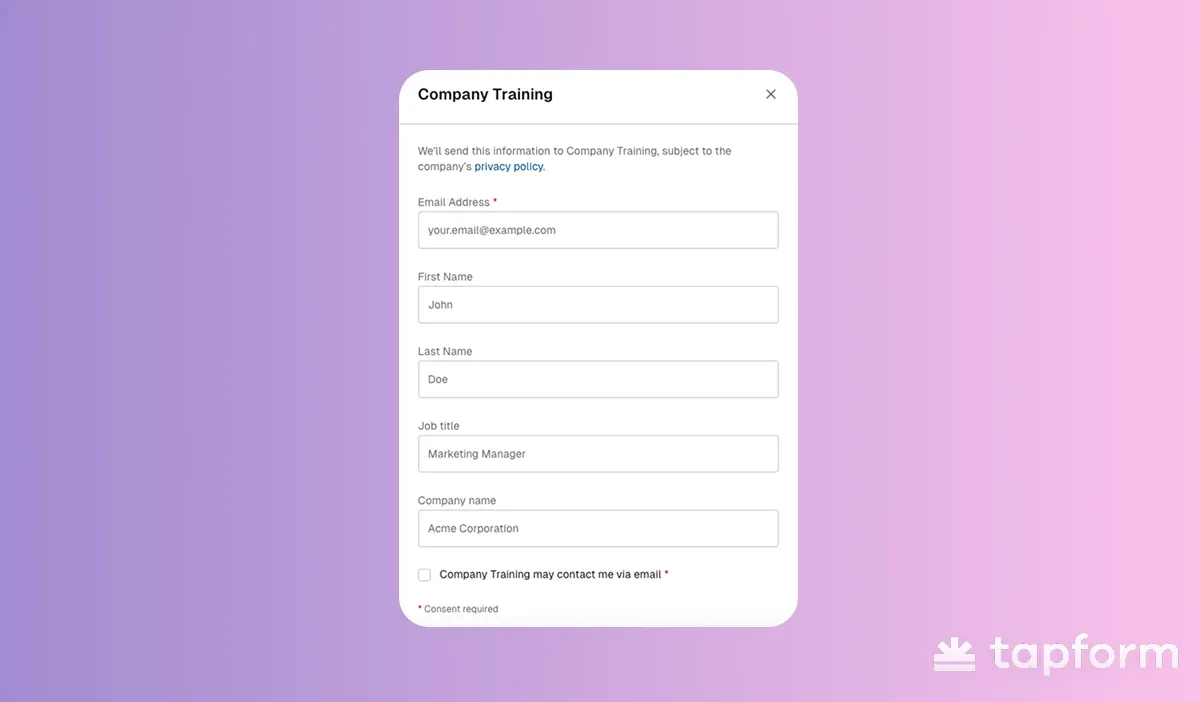
To create one, simply head to Campaign Manager, select Lead Generation as your objective, and attach your Lead Gen Form to your ad. The form builder allows you to set a clear headline (E.g., Download the B2B Sales Framework), write a short description of what value you are offering, and choose from which fields you want to collect information. Best practice is to stay simple - only ask for information that you will actually use.
TikTok Lead capture forms examples
The TikTok platform features native lead generation ads that combine vertical video content with an instant lead capture form within the app. Instead of sending users to an external landing page, they can submit their details directly within the TikTok app. And since forms can auto-fill profile data, such as name, email, and phone number, there is less friction throughout the entire process—the whole experience is fully optimized for mobile use.
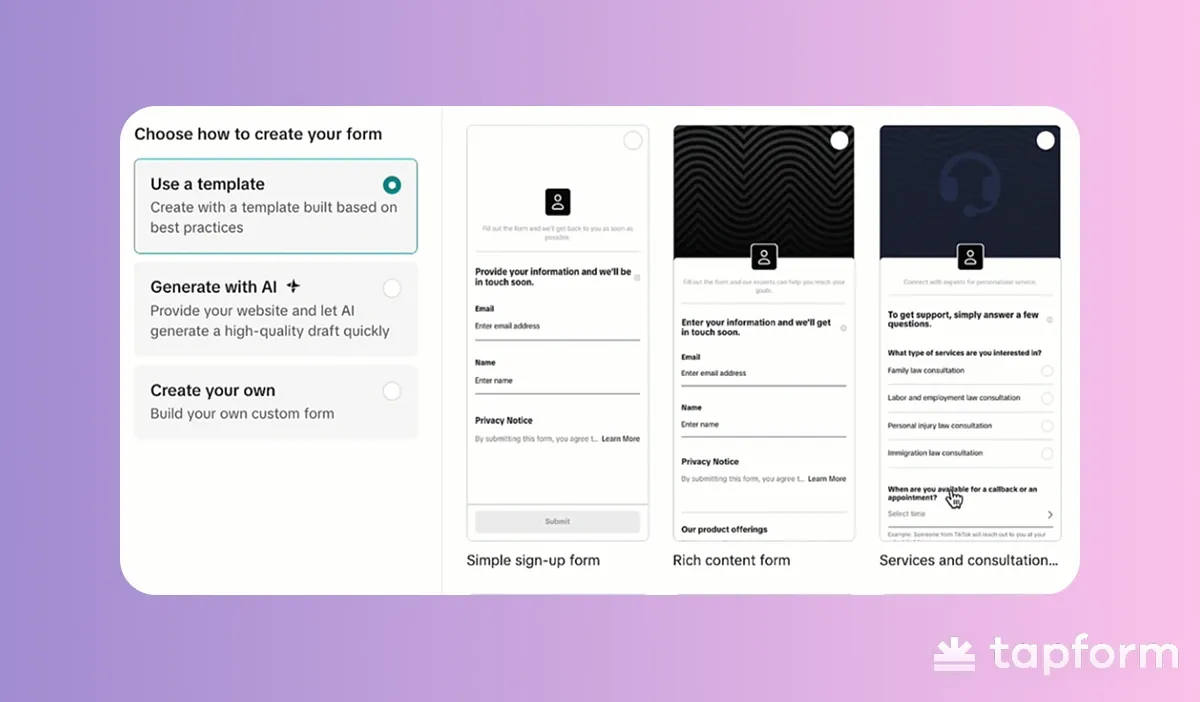
To set up a TikTok Lead Ad, Advertisers choose Lead Generation from the campaign objective set; the instant form is then attached to the video creative. The instant form fields can be edited with standard ones or kept customized with questions, allowing brands to ask only the questions most relevant to their business. Pre-filling some fields makes it very fast for the user to fill out, while marketers can, at the same time, qualify leads with customizable questions.
From e-commerce and local services to B2C products for younger buyers, TikTok’s discovery-driven and high-engagement environment enables broad brand awareness to be established quickly.
Elements of High-Converting Lead Capture Forms in Social Media
High-performing lead capture forms share:
- Short and simple structure
- Use of psychological triggers
- Clear trust signals
Form size matters. HubSpot research shows 3 to 5 fields work best. Too few fields give weak leads; too many cause users to leave. For simple offers, request the name, email address, and phone number. For demos or consultations, consider requesting a role or company size. Use minimal fields to increase completion rates and lead quality.
Psychological triggers boost action. Reciprocity means give before asking. Scarcity means limited spots. Clarity means easy to understand. On mobile, forms should load quickly, look visually appealing, and enable autofill.
Trust builds confidence. Use GDPR checkboxes, privacy links, or testimonials. Newsletter forms need only two fields and a privacy note. Demo requests benefit from proof, such as customer logos or case studies.
Measuring and Improving Your Lead Capture Success
Tracking performance is as important as building the form. Focus on key metrics, such as cost per lead (CPL), conversion rate (CVR), click-through rate (CTR), and form abandonment rates. These metrics help you understand both the quantity of leads generated and the efficiency of your lead generation process. Prioritize improving the metrics that have the most significant impact on your goals.
Set up precise tracking. Use UTM parameters to attribute leads, Meta Pixel, or LinkedIn Insight Tag to measure actions, and connect forms to your CRM for fast follow-up.
Test with structure. A/B test one variable at a time, such as headlines, CTAs, or form fields. Tools like Google Analytics, ad dashboards, or heatmaps reveal drop-offs and conversion drivers.
Go beyond metrics. Lead scoring models such as BANT or CHAMP help identify the most promising leads.

